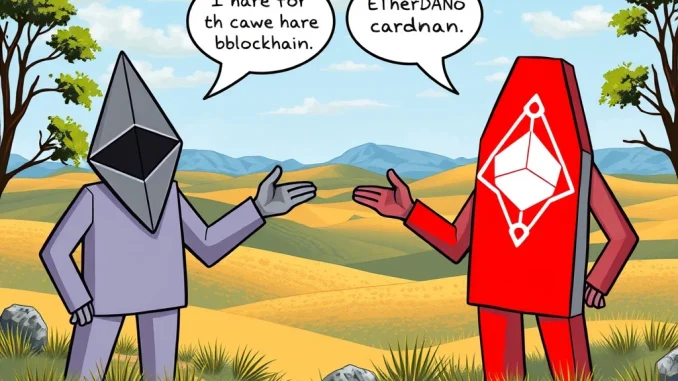
The world of cryptocurrency thrives on innovation, competition, and often, passionate debate among its leading figures. A recent exchange on social media has reignited discussions about the future viability of major blockchains, pitting a prominent voice from the Solana ecosystem against the founder of Cardano. This particular exchange centers on the ongoing rivalry between Ethereum, the second-largest cryptocurrency by market cap, and its competitors.
Cardano Founder Charles Hoskinson on Ethereum’s Future
The latest round of public sparring was initiated by Charles Hoskinson, the founder of Cardano and a co-founder of Ethereum. During a recent ‘ask me anything’ (AMA) session, Hoskinson offered a stark comparison for Ethereum’s long-term prospects. He likened Ethereum to BlackBerry, the once-dominant smartphone maker that was eventually overtaken by the iPhone.
Hoskinson suggested that, much like BlackBerry’s fate, Ethereum might not survive the next 10 to 15 years in its current form or position. This comparison implies that Ethereum, despite its current dominance in areas like DeFi and NFTs, could become obsolete or significantly marginalized by newer, more agile technologies.
His critique often stems from perceived limitations in Ethereum’s scalability, complexity, and governance, areas where projects like Cardano aim to offer alternative solutions.
Mert Mumtaz of Helius Responds to the Crypto Debate
The commentary from Hoskinson did not go unnoticed. Mert Mumtaz, the CEO of Helius, a leading developer platform built on the Solana blockchain, quickly offered a pointed response on X (formerly Twitter). Mumtaz directly addressed Hoskinson’s criticism of Ethereum, but pivoted the focus towards Cardano’s own standing in the market.
Mumtaz challenged Cardano’s position by stating it should first secure at least a 10% market share in *any* single significant metric within the crypto space before its founder makes such sweeping claims about Ethereum’s demise.
While acknowledging that Ethereum certainly has its shortcomings – a point many in the industry agree on – Mumtaz argued that it possesses significantly more substance and real-world usage compared to Cardano. He went further, describing Cardano as essentially “vaporware” in the context of genuine competition within the decentralized application space.
This response highlights a common point of criticism leveled against Cardano by proponents of other chains: despite its strong theoretical foundations and research-driven approach, its ecosystem activity, developer adoption, and dApp usage metrics often lag behind those of Ethereum and even newer chains like Solana.
Why This Debate Matters for Ethereum, Cardano, and Beyond
Public exchanges between prominent figures like Charles Hoskinson and Mert Mumtaz are more than just social media drama. They reflect deeper ideological and competitive divides within the blockchain industry. They bring attention to:
- Technological Approaches: Highlighting different philosophies (e.g., Ethereum’s iterative development vs. Cardano’s peer-reviewed research).
- Market Position: Underscoring the intense competition for market share, developer talent, and user adoption.
- Ecosystem Development: Drawing attention to the maturity and activity levels of different blockchain ecosystems.
- Community Sentiment: Influencing how communities perceive their own project and rivals.
For investors and developers, these debates serve as reminders to look beyond marketing and evaluate projects based on tangible metrics, adoption, and the health of their ecosystems. While future predictions are inherently uncertain, current utility and developer activity provide clearer signals.
Challenges and Realities
Both sides of this particular debate touch upon real challenges. Ethereum faces hurdles related to scaling transaction throughput and reducing gas fees, although significant progress has been made with Layer 2 solutions and the transition to Proof-of-Stake. Cardano, on the other hand, faces the challenge of translating its foundational research and development into widespread adoption and a vibrant dApp ecosystem that can genuinely compete with established networks.
Mert Mumtaz’s challenge to Cardano regarding market share metrics points to a key area where the network needs to demonstrate significant growth to validate its long-term vision as an “Ethereum killer” or even a major competitor.
Conclusion: The Ongoing Quest for Blockchain Dominance
The exchange between Charles Hoskinson and Mert Mumtaz is a microcosm of the broader competition in the blockchain space. While Hoskinson predicts potential decline for Ethereum, Mumtaz counters by questioning Cardano’s current impact and substance. These debates, while sometimes sharp, are a natural part of a rapidly evolving industry striving to build the future of decentralized technology. Ultimately, the success and longevity of any blockchain will likely depend less on predictions and more on its ability to attract users, developers, and deliver real-world value consistently over time.



